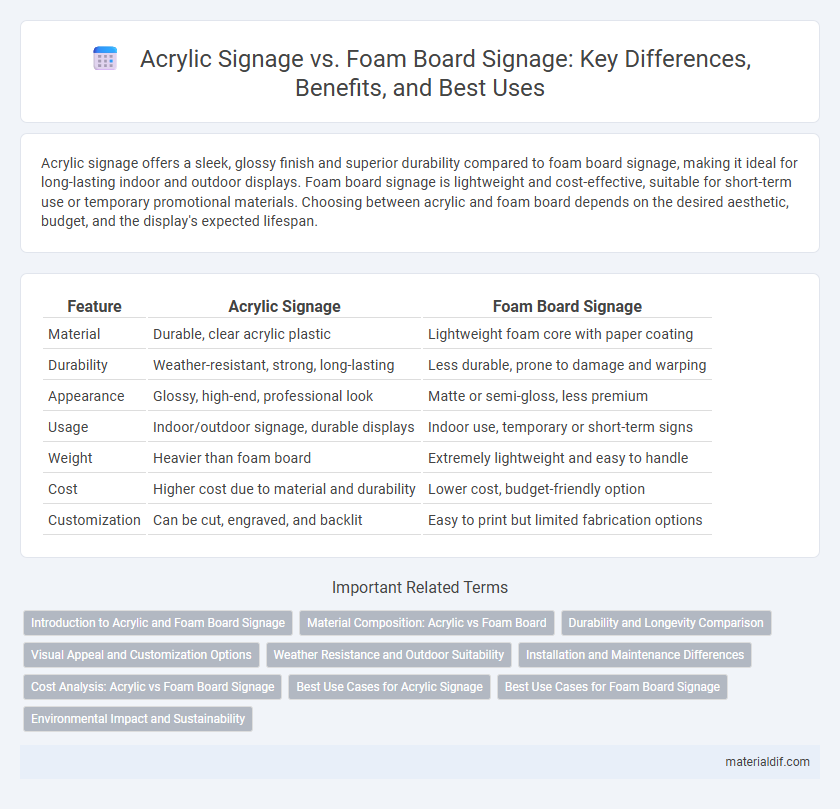Acrylic signage offers a sleek, glossy finish and superior durability compared to foam board signage, making it ideal for long-lasting indoor and outdoor displays. Foam board signage is lightweight and cost-effective, suitable for short-term use or temporary promotional materials. Choosing between acrylic and foam board depends on the desired aesthetic, budget, and the display's expected lifespan.
Table of Comparison
| Feature | Acrylic Signage | Foam Board Signage |
|---|---|---|
| Material | Durable, clear acrylic plastic | Lightweight foam core with paper coating |
| Durability | Weather-resistant, strong, long-lasting | Less durable, prone to damage and warping |
| Appearance | Glossy, high-end, professional look | Matte or semi-gloss, less premium |
| Usage | Indoor/outdoor signage, durable displays | Indoor use, temporary or short-term signs |
| Weight | Heavier than foam board | Extremely lightweight and easy to handle |
| Cost | Higher cost due to material and durability | Lower cost, budget-friendly option |
| Customization | Can be cut, engraved, and backlit | Easy to print but limited fabrication options |
Introduction to Acrylic and Foam Board Signage
Acrylic signage offers a sleek, durable, and weather-resistant option commonly used for high-impact visual displays, featuring a glossy finish that enhances color vibrancy. Foam board signage is lightweight, cost-effective, and easy to handle, ideal for temporary indoor promotions or presentations with a matte surface that reduces glare. Both materials serve distinct purposes in advertising, with acrylic favored for longevity and a premium look, while foam board provides versatility and affordability.
Material Composition: Acrylic vs Foam Board
Acrylic signage is made from polymethyl methacrylate (PMMA), a durable thermoplastic known for its clarity, strength, and resistance to weathering, making it ideal for long-lasting, high-quality displays. Foam board signage consists of a lightweight, polystyrene foam core sandwiched between paper or plastic sheets, offering an inexpensive and easy-to-handle option for temporary indoor use. The solid, non-porous nature of acrylic provides superior durability and a glossy finish, whereas foam board's porous and delicate structure limits its outdoor and heavy-duty applications.
Durability and Longevity Comparison
Acrylic signage outperforms foam board signage in durability due to its resistance to moisture, UV rays, and physical impact, making it ideal for both indoor and outdoor use. Foam board signage, while lightweight and cost-effective, is prone to warping, water damage, and fading, significantly reducing its lifespan. The longevity of acrylic signs often exceeds several years without significant wear, whereas foam board signs typically last only a few months under similar conditions.
Visual Appeal and Customization Options
Acrylic signage offers a sleek, glossy finish with vibrant color depth and high transparency, making it ideal for premium visual appeal in retail and corporate environments. Foam board signage provides a lightweight, matte surface that supports easy printing and cost-effective customization for temporary or indoor displays. Customization options for acrylic include laser etching, edge lighting, and layered designs, while foam board excels with quick mounting, die-cut shapes, and budget-friendly full-color prints.
Weather Resistance and Outdoor Suitability
Acrylic signage offers superior weather resistance compared to foam board signage due to its durable, non-porous surface that withstands rain, UV rays, and temperature fluctuations without warping or fading. Foam board signs, made of lightweight, porous materials, tend to absorb moisture and degrade quickly when exposed to outdoor elements, making them less suitable for long-term outdoor use. For businesses seeking long-lasting outdoor signage, acrylic is the preferred choice due to its robustness and ability to maintain visual clarity over time.
Installation and Maintenance Differences
Acrylic signage offers a sleek, durable surface that requires mounting hardware such as standoffs or adhesives, making installation more precise but potentially time-consuming. Foam board signage is lightweight and can be easily mounted using tape, hooks, or lightweight frames, enabling quicker installation with minimal tools. Maintenance for acrylic involves regular cleaning with non-abrasive solutions to maintain its glossy finish, while foam board signage is more susceptible to damage from moisture and requires gentle handling to prevent warping or tearing.
Cost Analysis: Acrylic vs Foam Board Signage
Acrylic signage typically incurs higher upfront costs compared to foam board signage due to the durable, glossy material and professional fabrication required. Foam board signs offer a more budget-friendly option, favored for short-term use or indoor applications where cost efficiency is paramount. Evaluating long-term value reveals acrylic signs have greater durability and resistance to environmental wear, potentially reducing replacement frequency despite their initial expense.
Best Use Cases for Acrylic Signage
Acrylic signage excels in high-end retail displays, corporate branding, and outdoor signage due to its durability, weather resistance, and elegant polished finish. It is ideal for environments requiring long-lasting, premium visual appeal with clarity and UV resistance, such as storefronts and office lobbies. Acrylic's versatility in customization and ability to withstand harsh conditions make it the optimal choice for impactful, professional signage solutions.
Best Use Cases for Foam Board Signage
Foam board signage offers lightweight and cost-effective solutions ideal for temporary displays, indoor presentations, and short-term marketing campaigns. Its easy-to-cut and mount properties make it perfect for trade shows, event signage, and presentation boards where quick setup and portability are essential. Foam board's affordability and versatility also cater to classrooms and office environments requiring frequent updates or changes.
Environmental Impact and Sustainability
Acrylic signage, made from durable polymethyl methacrylate, presents challenges in recyclability and often contributes to long-term plastic waste due to its non-biodegradable nature. Foam board signage, typically composed of polystyrene foam with paper facings, is lightweight and cost-effective but has a higher environmental footprint because polystyrene is difficult to recycle and can release harmful chemicals during degradation. Choosing sustainable signage options involves prioritizing materials with better recyclability and lower toxic emissions, favoring innovations such as biodegradable foam boards or recycled acrylic alternatives.
Acrylic Signage vs Foam Board Signage Infographic

 materialdif.com
materialdif.com